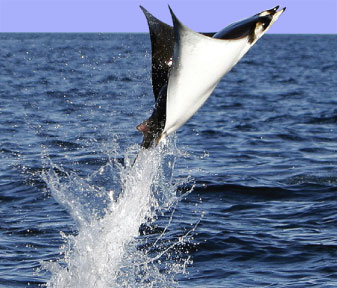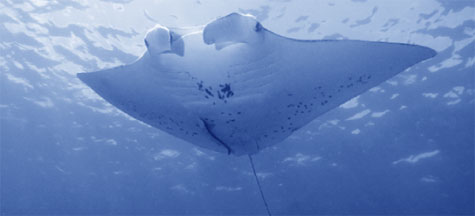|

Paul Hilton
The Chinese love the manta ray for food and medicine making it a
lucrative market for its gill rakers which is pushing the species
towards extinction the world over. The huge, dark manta ray swims
effortlessly from the depths reaching surface and floats motionlessly.
Swimming in a series of loops, its white underbelly is exposed reaching
a 3 metre wing span.
Diving deep, it returns for another fly-by. Its graceful moves and
massive size is a diver’s dream but they are becoming increasingly rare.
Research and encounters with marine scientists revealed that manta rays
are becoming increasingly valuable for their gill rakers (finger-like
projections of the gills that help filter-feeding animals retain food),
which are used in Chinese medicine.
Manta rays caught accidentally by gillnet fishermen hunting tuna are
now almost always kept. The meat is dried and salted for human
consumption while ray cartilage is used as a filler for shark fin soup.
 Demand for gill rakers has given rise to unsustainable manta ray
fisheries off the coasts of Mexico and the Philippines. In 2004, manta
rays were identified by the Convention on International Trade in
Endangered Species (www.cites.org/) as a group associated with
significant unregulated, unsustainable fishing and severe population
depletion. In 2005, the IUCN Red List of Threatened Species (produced by
the International Union for Conservation of Nature and Natural
Resources) classified the manta ray as “near threatened”. Demand for gill rakers has given rise to unsustainable manta ray
fisheries off the coasts of Mexico and the Philippines. In 2004, manta
rays were identified by the Convention on International Trade in
Endangered Species (www.cites.org/) as a group associated with
significant unregulated, unsustainable fishing and severe population
depletion. In 2005, the IUCN Red List of Threatened Species (produced by
the International Union for Conservation of Nature and Natural
Resources) classified the manta ray as “near threatened”.
The governments of Mexico and the Philippines made it illegal to
capture and kill mantas, but then lifted the bans. Both countries list
their local stock of manta rays as DD/NT - “data deficient” and “near
threatened”.
In Sri Lanka, at the small fishing port of Mirissa, we count 23 dead
manta rays in one morning. According to the fishermen, manta rays are
landed everyday here, in just one port in one town in one country.
The next day, at the same spot, we count 20; the following day, 15. I
have never seen so many manta rays in one place. The mantas are sold in
two parts: the head and the rest of the fish. The head fetches 500
rupees including all 10 gills. Once sold, the manta’s head is hacked up
to get to the gills. The same fishmongers who were finning sharks, now
go to work on the manta rays’ heads, separating the gill rakers from the
fleshy parts that hold them in place. These concertina-looking filters
are much in demand by Asian restaurants and diners. The rest of the ray
is either sold cheaply to locals for use in fish curry or is left to
waste.
We are told that the gill rakers and shark fins are taken to a
warehouse in Matara, 30 minutes from Mirissa. Upon arrival, we find
shark fins all over the floor, divided into piles according to species;
long-finned mako sharks, hammerheads, oceanic white-tips.
The traders are keen to talk and invite us to take a closer look.
Inside, on shelves, are clear plastic sacks crammed with dried manta ray
gill rakers. The proprietor tells us that each of the four sacks
contains gill rakers from about 100 manta rays. We are taken to the
roof, where gill rakers and shark fins are being dried. According to the
staff, 1kg of shark fin sells for 1,500 rupees while the same weight of
gill rakers sells for 4,000 to 5,000 rupees.
Until recently the gestation period of manta rays was uncertain.
Estimates ranged from one to three years.However, scientists still don’t
know at what age they reach maturity. Some believe it is about six to
eight years for females, who grow to between 3.8 metres and 4.5 metres
across (depending on region and species). They usually have a single pup
- but twins are not unknown - born measuring about 1.5 metres to 1.9
metres across. No one knows how long manta rays naturally live for but
it is at least 30 years.
For all scientists know, they could live for more than 100 years,
like some whale sharks. Scientists fear that a combination of slow
maturation, long gestation and infrequent pregnancies means manta ray
populations cannot replenish themselves as fast as man is catching and
killing them.
Manta rays, which are found worldwide in tropical and temperate
waters, are divided into at least two, possibly three distinct species,
with visually identifiable characteristics, as well as unique behaviour
and lifestyles.
 There is the pelagic, elusive, migratory manta and its smaller
cousin, the resident ray, which lives in the same area year-round and is
often encountered around coral reefs, where they congregate to be
cleaned by parasite-eating fish or to feed. They could attract millions
of dollars in eco-tourism, which could play a part in their
conservation. There is the pelagic, elusive, migratory manta and its smaller
cousin, the resident ray, which lives in the same area year-round and is
often encountered around coral reefs, where they congregate to be
cleaned by parasite-eating fish or to feed. They could attract millions
of dollars in eco-tourism, which could play a part in their
conservation.
Eco-tourism generates the money and attention needed to influence
governments and increase public awareness of the plight of creatures
such as the manta ray but experts warn that eco-tourism can also be
destructive and unsustainable if it is not controlled or regulated and
it can have just as negative an effect on a population as fishing.
Demand for dried gill rakers for traditional medicines has increased
dramatically; the skin, meat and gill rakers of a mature Indonesian
manta sell well.
In Hong Kong, gill rakers - called peng yu sai - are believed to
reduce toxins in the blood by purifying and “cooling” it, especially in
those whose core temperature is too warm, according to practitioners of
traditional Chinese medicine. Also, as shark fin becomes harder to find,
rakers are being offered as an alternative, increasing demand further.
The manta ray may not be endangered yet but unless they are given
some protection, these creatures soon will be. It’s time to reflect on
the mistakes we have made and move to a more sustainable and frugal way
of life - for the future of all living creatures, including ourselves. |

